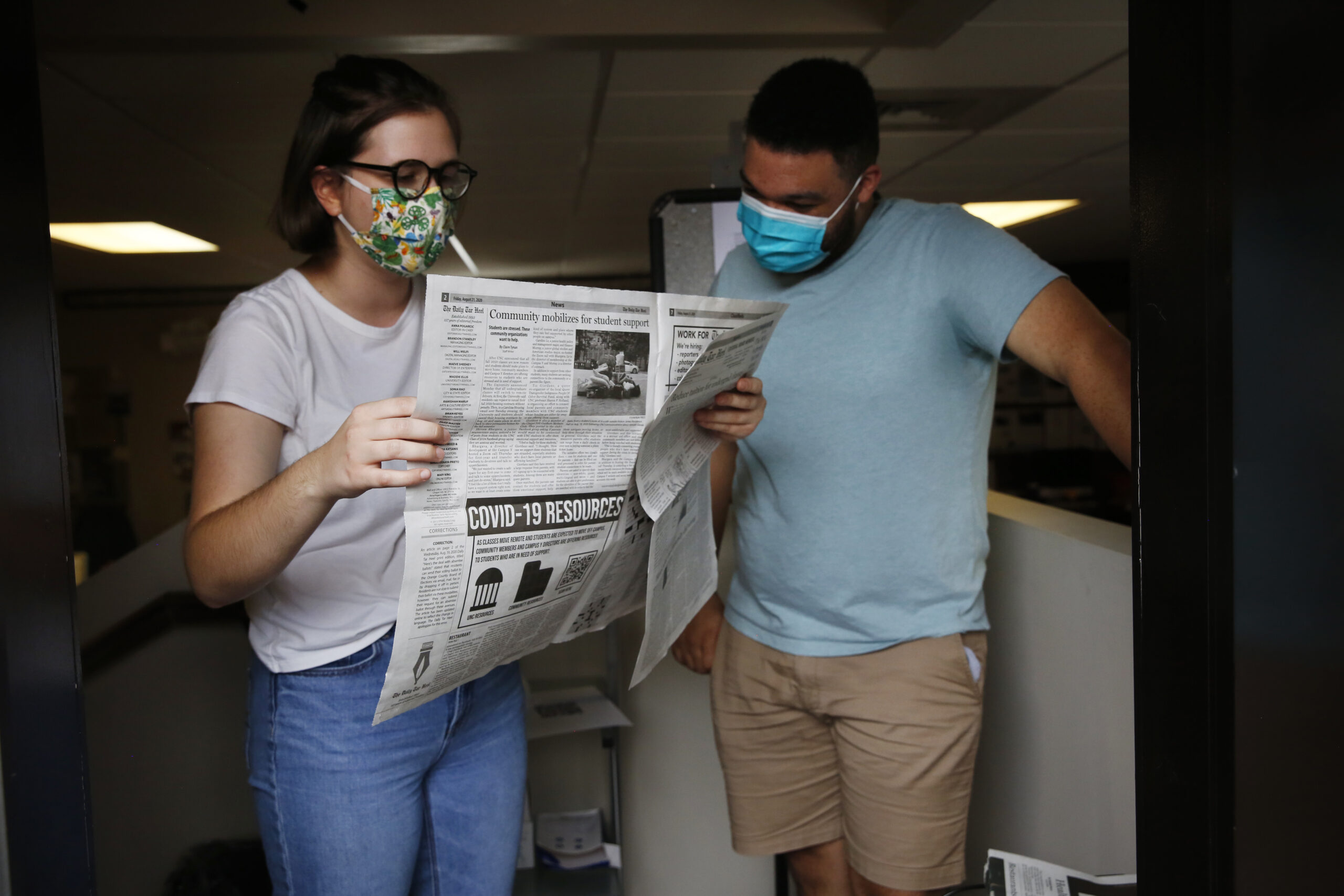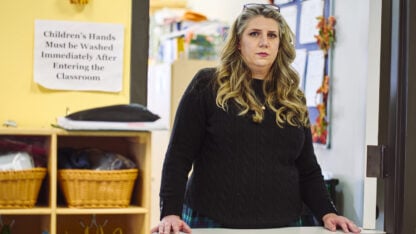‘We’re Living The News’: Student Journalists Are Owning The College Reopening Story

Student journalists Anna Pogarcic and Brandon Standley of UNC’s Daily Tar Heel review a recent issue at their offices off campus.
Elissa Nadworny / NPR
On the morning of Friday, Aug. 14, The Daily Tar Heel newsroom got a tip: The University of North Carolina at Chapel Hill was about to announce clusters of positive coronavirus cases in student housing, after only a week of in-person classes. The student-led independent newspaper broke the news before the university sent its campus-wide alert.
Over the weekend, more news of clusters trickled in — this time at a fraternity house and another dorm.
On Sunday, Editor-in-chief Anna Pogarcic says, the opinion editor decided to scrap the planned Monday editorial, and pivot to address the rapidly devolving reopening plan the university had been touting all summer. After a late-night power outage, Monday’s issue barely made it to the printer in time. The next day, tucked away on page 3, the new editorial headline proclaimed “UNC has a clusterf*** on its hands.” A photo of the headline quickly went viral.
“We thought that would be the peak of the week,” says Pogarcic, “it couldn’t possibly get worse.” And then it did: UNC moved classes online hours later, and requested that students begin moving off campus.
Student journalists, like those at The Daily Tar Heel, have been tirelessly reporting on college reopening plans — and their editorials haven’t held back. One headline from students at the University of Kansas read, “KU must reverse course now on campus reopening;” another, from the student-run newspaper at the University of Notre Dame, declared, “Don’t make us write obituaries.” And the news stories haven’t let up — stories about reopening plans, testing on campus, hybrid or online learning, and of course, what all of this has been like for students.
“There’s too much happening right now, and I don’t think that that’s going to let up anytime soon,” says Emily Hernandez, a junior at the University of Texas at Austin and a news editor for The Daily Texan. “The hardest part is just trying to keep up with everything.”
Her paper’s operations are now all remote, with staff working from home to put out stories. And it isn’t always easy covering issues that affect her and her friends. Sometimes, she says, it gets to be too much.
“It’s kind of taken a toll on my friendships,” says Hernandez, who often talks about her stories and the issues they cover with her friends. “They’ve told me that it’s really sad and draining to hear that from me because it’s so scary.”
Brandon Standley, managing editor at The Daily Tar Heel, says student journalists are perfectly positioned to cover the college reopening story — their own questions help inform story ideas and insights for readers. And sourcing is easy. “A friend of a friend is a great source,” Standley says.
Standley is proud to work at The Daily Tar Heel, which has been covering campus since 1893. The newsroom is covered with old issues from years past. The headlines span everything from basketball championships to investigative reporting on sexual assault on campus — and now, this semester’s non-stop reopening news.
But like Hernandez, Standley says it takes a toll. He lives on campus, and he’s a resident advisor — so both his housing and his job are linked to the university.
“We are scared because not only is this news that we’re writing about for other people to hear, we’re also hearing about it ourselves for the first time usually when we’re writing about it.”
The weight of The Daily Tar Heel’s coverage didn’t hit Anna Pogarcic until a few days after classes went online. She was driving her roommate on an errand, thinking about her own start at UNC, and how she had worked so hard to attend the state’s flagship school. If she had been entering her freshman year with all of this happening, she says, she may have chosen to go to a community college instead. In her car, away from her ever-vibrating phone and the busy newsroom, Pogarcic cried.
“This is our job and our life,” she says. “We’re living the news we’re reporting on.”
And their reporting has had an impact. After the university first announced there were coronavirus clusters on campus, Pogarcic says The Daily Tar Heel asked for the specific number of cases. At first, the university declined to give those numbers, citing FERPA, a federal privacy law that protects students’ education records. The Daily Tar Heel responded with a story that questioned the legal grounds to that argument, and the next day, UNC released the case numbers.
This reporting didn’t just start when students moved back to campus — The Daily Tar Heel has been covering the pushback to UNC’s reopening plan all summer.
“Every week I would edit a story that was about campus workers or students saying, ‘Why are we doing this? What are you going to do when a student tests positive?’” says Maydha Devarajan, a UNC junior who worked for the paper over the summer. “There’s no way I could have stopped this university from opening, but I hope I put enough information out there to show that there was a large amount of backlash to this plan before it even took off.”
The national headlines about UNC may be receding, but the journalists at The Daily Tar Heel still have a big story to cover. Anna Pogarcic says their main goal is to keep the university accountable. She’s driven by two central questions: “What is the university not telling us? What should they be telling us?”
There are other questions, too: How are students doing at home? Did they take the coronavirus back to their families? Will the university ever apologize for the botched reopening? And a big one: Is this going to happen again in the spring?
On Saturday, as Brandon Standley wrapped up his interview with NPR, a message came in. The university was about to announce another cluster in a dorm building, this time at Craige Residence Hall, where Standley lives and works as an RA. But there’s no time to think about what the cluster might mean for him personally — there are Slack messages to send, tweets to craft and a story to publish. It’s time to break news.
9(MDAxODM0MDY4MDEyMTY4NDA3MzI3YjkzMw004))








